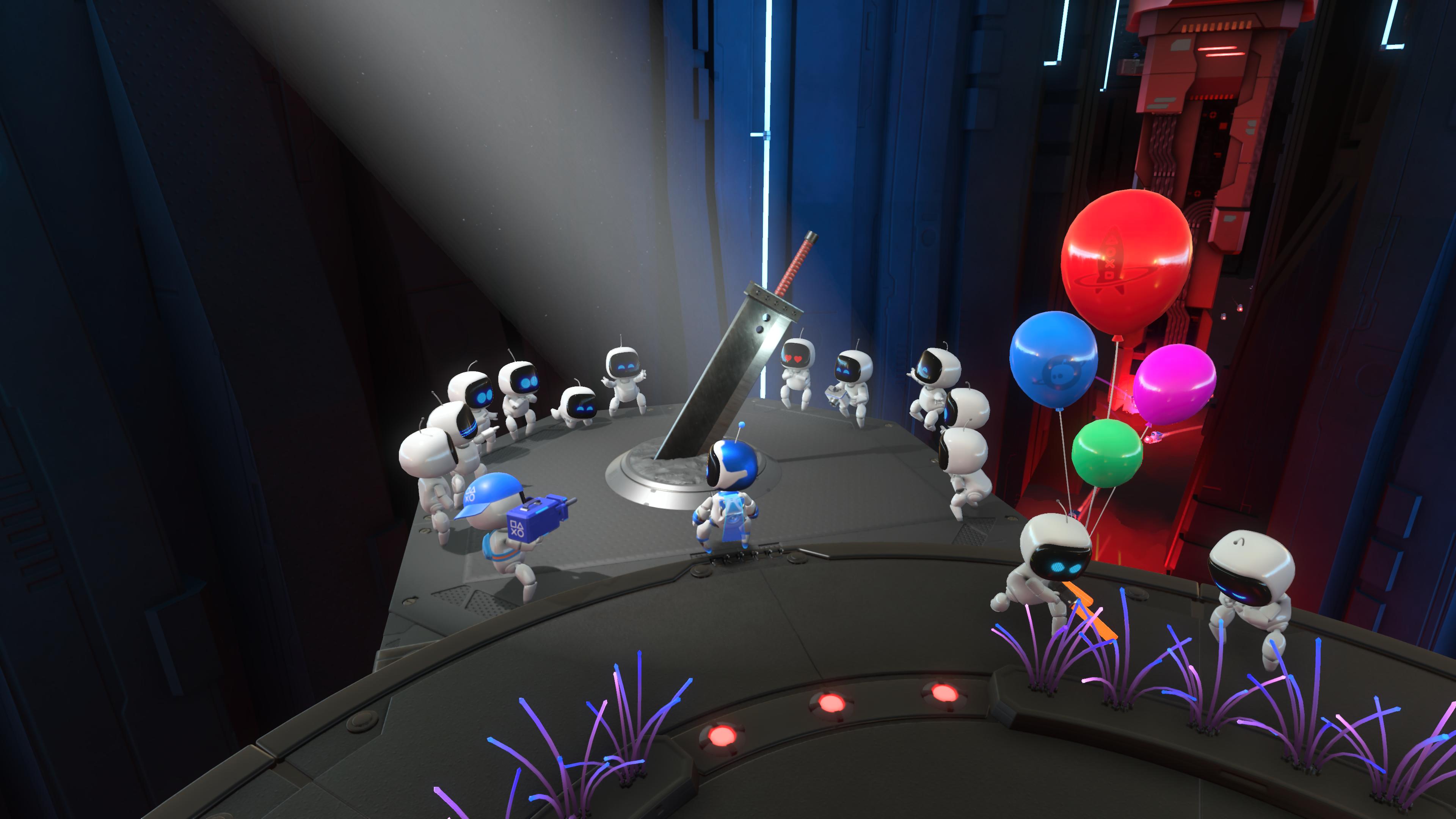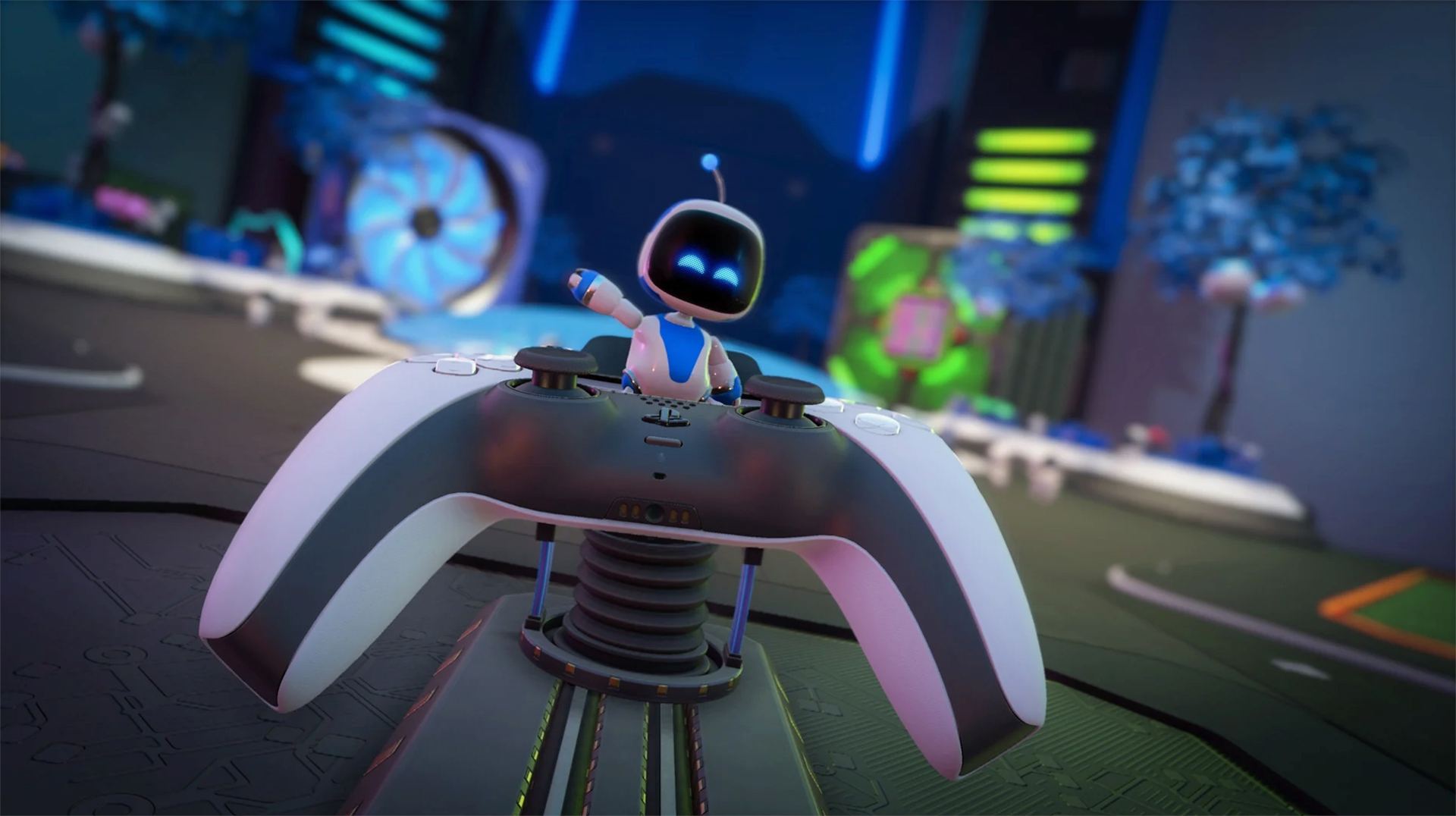Purrr....
- FREE!
- Love letter to PlayStation history
- Collecting
- Utilizes the DualSense controller
- Soundtrack
- Fun platformer
Hisss!
- Too short
- Touchpad gameplay becomes tedious
Platform
PlayStation 5Publisher
Sony Interactive EntertainmentDeveloper
SIE Japan StudioSeries
Astro BotGenre
PlatformPlayers
1File Size (Minimum)
10.98 GBRelease Date (NA)
Nov 12, 2020Release Date (JP)
Nov 12, 2020Purchase From
Filed Under
Astro’s Playroom is a free game for everyone who purchases a PlayStation 5 console. It not only showcases the history of the PlayStation franchise, it also utilizes the PlayStation 5’s DualSense controller extremely well. This freebie game is well worth your time when you start up your PlayStation 5.
Meet Astro

The game features the lovable robots that were first introduced in the free 2013 game, The Playroom, for the PlayStation 4. That title showcased the Dualshock 4 controller and camera. Then Astro himself began to shine in the 2018 PlayStation VR game, Astro Bot: Rescue Mission. The game introduced players to the PlayStation VR headset and received high praise for its unique fun factor and gameplay. With the launch of the PlayStation 5, it makes sense to bring Astro and company along as a launch title.
Collect Them All!

In Astro’s Playroom, get ready to walk down PlayStation memory lane and see lots of easter eggs along the way. As you traverse the different levels, you’ll encounter your favorite scenes from big, impactful games such as Final Fantasy VII, Silent Hill, Resident Evil, PaRappa the Rapper, Crash Bandicoot, Tomb Raider, and more. Many scenes are reenacted by the little robots, making it a feast for those who have played on PlayStation consoles for years.
The main goal of Astro’s mini adventure is collecting artifacts of PlayStation history. There are four levels to explore, and after finishing each one, you’ll earn a piece of history for each PlayStation console: the original PlayStation, PlayStation 2, PlayStation 3, and PlayStation 4. Yes, there are other systems, as well, such as the PlayStation Portable (PSP), Vita, and their accessories. They are scattered across each level, though some can be found by spending coins at a crane game. There are also puzzle pieces scattered around, too. Collecting them builds a mosaic art of PlayStation history.
Collecting in Astro’s Playroom is enjoyable and the game makes it easy enough to see which places in each level are missing. Players can also teleport instantly to those specific stages in each level, as long as they were already played. Very convenient.
After going through all four levels, you’ll unlock a new area where you’ll face a polygon boss from 1994. The battle is enjoyable to play, even if it is easy. It’s too bad that, outside of collecting, there isn’t any more to play after this, though. The game begs for improvement with add-on material. The Playroom received extra content, so it wouldn’t be a surprise if more also comes to Astro’s Playroom.
The platformer level design is rich, colorful, and fun to explore. Planned out quite well, the game cleverly uses components of PlayStation hardware, such as the DualShock’s wires for walking across islands. From neon lights in the speedway level to the vibrant jungle, it’s very detailed.
It’s In Your Hands

One of the biggest parts of the game is showcasing the power of the DualSense’s capabilities. Astro’s Playroom first introduces the controller’s power when playing the game for the first time. It’s a treat, and it highlights how wild the DualSense’s adaptive triggers can be. Shooting an arrow has a different feedback compared to flying a spaceship. Raindrops vibrate the controller with a soft rumble and the wind blowing at Astro causes much different vibrations. Compared to the DualShock 4 controller for the PlayStation 4, each impact feels so much more precise.
You’ll have chances to use the microphone feature by blowing air to make objects move. This feels similar to the Nintendo 3DS’s microphone capabilities in some of their games. The gamepad feels similar to the DualShock 4 and you’ll utilize it more with one of the levels where Astro jumps into a ball. You’ll move the ball around the ground and across narrow pathways. While moving, the player’s first instinct would be to tilt the controller, since the DualSense has built-in motion sensors. After all, in other parts of the game where you’ll fly or jump in robotic suits, you’ll use the DualSense to tilt the controller to navigate. However, in this scenario, it’s all about the touchpad. It gets a bit annoying to navigate, but thankfully, it doesn’t last too long in the level.
Because Astro’s Playroom utilizes the DualSense at a high level, one wonders how other PlayStation 5 games will use the DualSense and whether they’ll come close to the same level as Astro’s Playroom. It’s the same puzzle designers and developers faced with the Nintendo Wii’s Wii remote, in that it will take them time to understand the device’s capabilities.
Electronic Beats
Astro’s Playroom’s soundtrack is catchy, from its cheerful opening to its electronic beats in the speedway level. The 1994 throwback level gives off a dark vibe that fits well in a polygon boss battle. The soundtrack was composed by Kenneth Young, best known for his work on the Little Big Planet franchise. It’s well worth a listen, and if you decide to put the controller down just to enjoy the music, you’re not alone.
The Final Artifact
Astro’s Playroom is well worth your time as one of your first games on your shiny, new PlayStation 5. Considering that it takes full advantage of the DualSense’s features, has fun platform levels and a catchy soundtrack, and it’s FREE, it’s hard to not like Astro’s Playroom. It’s just unfortunate that it’s so short. Astro and his friends deserve a full-length platformer! Until then, I’ll be hanging out with my bot buddies.











